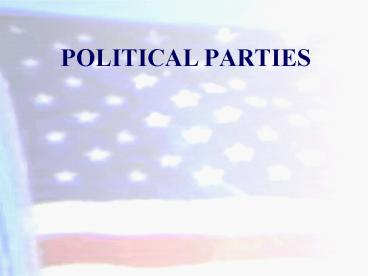POLITICAL PARTIES - PowerPoint PPT Presentation
1 / 29
Title:
POLITICAL PARTIES
Description:
Hamilton and Jefferson, as heads of the Federalist and Anti ... 1856: Millard Fillmore's American Party. The Basic Structure of American Political Parties ... – PowerPoint PPT presentation
Number of Views:2425
Avg rating:3.0/5.0
Title: POLITICAL PARTIES
1
POLITICAL PARTIES
2
What is a Political Party?
- A political party is a group of voters,
activists, candidates, and office holders who
identify with a party label and seek to elect
individuals to public office.
3
The Evolution of American Party Democracy
- Hamilton and Jefferson, as heads of the
Federalist and Anti-Federalist groups
respectively, are often considered 'fathers' of
the modern party system. - By 1800, this country had a party system with two
major parties that has remained relatively stable
ever since.
4
(No Transcript)
5
Democrats and Republicans The Golden Age
- From the presidential elections of 1860 to the
present, the same two major parties have
contested elections in the United States
Democrats and Republicans. - Reconstruction -- Republican dominance
- 1876-1896 -- closely competitive
- 1896-1929 -- Republican dominance
- 1930s and 1940s -- Democratic dominance
- 1950s and 1960s -- closely competitive
- 1970-present -- neither party dominant
6
Coalition - major political groupings that have
shaped American policy.
- New Deal Coalition
- 1932 - F.D. Roosevelt
7
A New Deal liberal believes
- Using the power of govt to solve problems
- a strong presidency
- curb big business, help the underdog
- not much objection to taxes or deficits
- favors labor and working persons
- minorities
- supports govt action to foster employment
- help those unable to help themselves
- civil liberties
8
Loyalty Trends (today)- Democratic
- Labor union members tend to vote Democratic
- Democrats have a lead in garnering the women's
votes - Over 80 of African Americans and Hispanics vote
3 to 1 Democratic - Young people are again more Democratic
- Most blue collar workers and unemployed are
Democrats - Catholics and Jews are mostly Democrats
- The widowed are mostly Democrats
- Liberals tend to be Democrats
9
A Classic Conservative believes
- Best govt is the least govt
- less taxes
- oppose deficits, balance budget
- de-centralization
- de-regulation (laissez-fair capitalism)
- stress patriotism and strong defense
- strong Congress
- appeals to affluent and middle class
10
Loyalty Trends (today) - Republican
- Chambers of Commerce tend to vote Republican
- The West tends to be more Republican
- Men tend to split fairly evenly between the two
parties - Cuban Americans are generally Republicans
(anti-Castro) - Professionals, executives, and white collar
workers tend to be Republican - High status Protestants tend to be Republican
- Married couples tend to be Republican
- Conservatives tend to be Republican
11
The Roles of American Parties
- The two party system has been used to resolve
political and social conflicts. - Mobilizing Support and Gathering Power
- A Force for Stability
- Unity, Linkage, Accountability
- The Electioneering Function
- Party as a Voting and Issue Cue
- Policy Formulation and Promotion
12
Party Platform
- A formal statement of beliefs, opinions, and
policy stands tied together by a set of
underlying principles based on the partys
ideological orientation.
13
One-Partyism
- A significant trend of recent times is the demise
of one-partyism (one party dominance of elections
in a given region). - The formerly "Solid South" is no longer only
Democratic. - There are no Republican or Democratic states at
this time. - Many individuals split their vote between the
parties, and sometimes vote for third parties.
14
Minor Parties Third-Partyism
- Minor parties are not a threat to the two major
parties. - Only eight third parties have won any electoral
votes in a presidential contest. - The third parties that have had some success are
- 1996 and 1992 Ross Perots Reform Party
- 1968 George Wallaces American Independent Party
- 1924 Robert LaFollettes Progressive Party
- 1912 Teddy Roosevelts Bull Moose Party
- 1856 Millard Fillmore's American Party
15
The Basic Structure of American Political Parties
16
The Party in Government
- The Congressional Party
- The Presidential Party
- The Parties and the Judiciary
- The Parties and State Government
17
The Party-In-The-Electorate
- The party-in-the-electorate is the mass of
potential voters who identify with specific
party. - American voters often identify with a specific
party, but rarely formally belong to it. - Party identification is often a voter's central
political reference symbol. - Party identification generally come from one's
parents. - However party id can be affected by a number of
factors such as education, peers, charismatic
personalities, cataclysmic events, and intense
social issues.
18
Declining Party Loyalty?
- The number of independents in the U.S. rose from
19 in 1958 to 37 twenty years later. - Identification with the two major parties today
is in the mid 80 range. - Pollsters often find that many self declared
independents often 'lean' quite strongly to
either the Democrat or Republican party. - Leaners do feel party affiliations, but choose
not to self-identify with a party.
19
(No Transcript)
20
(No Transcript)
21
(No Transcript)
22
(No Transcript)
23
Who is in the drivers seat today?
- New Deal Coalition
- Conservative Coalition
- Moderates
- Ticket Splitters
- Single Elite
- ?
24
Why are Political Parties Important?
25
What do Parties do in Elections?
26
Whos Who and What are You?
27
Party Evolution
- Birth
- Adolescence
- Adulthood - Republican Era 1896-1928
- Democratic Era 1932-68
- Today?
28
Responsible Party Model -
- A party system in which each party offers clear
policy alternatives and holds their elected
officials responsible for enacting these policies
in office.
29
Multiparty Politics
- Pro
- Con































